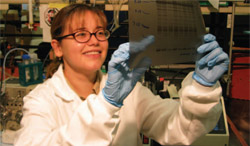
The NIH Blueprint for Neuroscience Research, which NIGMS actively participates in, recently announced the Blueprint Program for Enhancing Neuroscience Diversity through Undergraduate Research Education Experiences (BP-ENDURE).
The program will support the development of collaborative research education partnerships to increase the number of students from underrepresented groups who are well-prepared to enter and complete Ph.D. degree programs in the neurosciences. It will connect academic enhancement and research training activities at research-intensive institutions (such as those participating in the Jointly Sponsored Institutional Predoctoral Training Programs and the Initiative for Maximizing Student Development (IMSD) Program) and institutions that have substantial enrollments of undergraduate students from underrepresented groups majoring in areas relevant to the neurosciences. These activities must be designed to increase students’ interest in the neurosciences and better prepare them for graduate studies in the field.
The deadline to submit a letter of intent is February 24, 2010, and the application deadline is March 24, 2010. Please see the funding opportunity announcement or contact me if you need more information.



 NIH has announced the 2010 competitions for the NIH Director’s Pioneer Awards and the NIH Director’s New Innovator Awards. These awards support exceptionally creative scientists who propose highly innovative—and often unconventional—approaches to major challenges in biomedical or behavioral research. Both programs are part of the
NIH has announced the 2010 competitions for the NIH Director’s Pioneer Awards and the NIH Director’s New Innovator Awards. These awards support exceptionally creative scientists who propose highly innovative—and often unconventional—approaches to major challenges in biomedical or behavioral research. Both programs are part of the 


 If you plan to apply, be sure to read the recent NIH Guide notice applying to NRSAs. Effective with the August 8, 2009, submission date, NIH will only accept electronic applications for F-series programs. There are other changes, too, including how letters of reference are submitted, how many amended applications you may submit (only one), and how review is structured (there are now five review criteria). In addition, reviewers will use the new scoring system for individual fellowships starting with applications reviewed at the summer 2009 study section meetings.
If you plan to apply, be sure to read the recent NIH Guide notice applying to NRSAs. Effective with the August 8, 2009, submission date, NIH will only accept electronic applications for F-series programs. There are other changes, too, including how letters of reference are submitted, how many amended applications you may submit (only one), and how review is structured (there are now five review criteria). In addition, reviewers will use the new scoring system for individual fellowships starting with applications reviewed at the summer 2009 study section meetings.